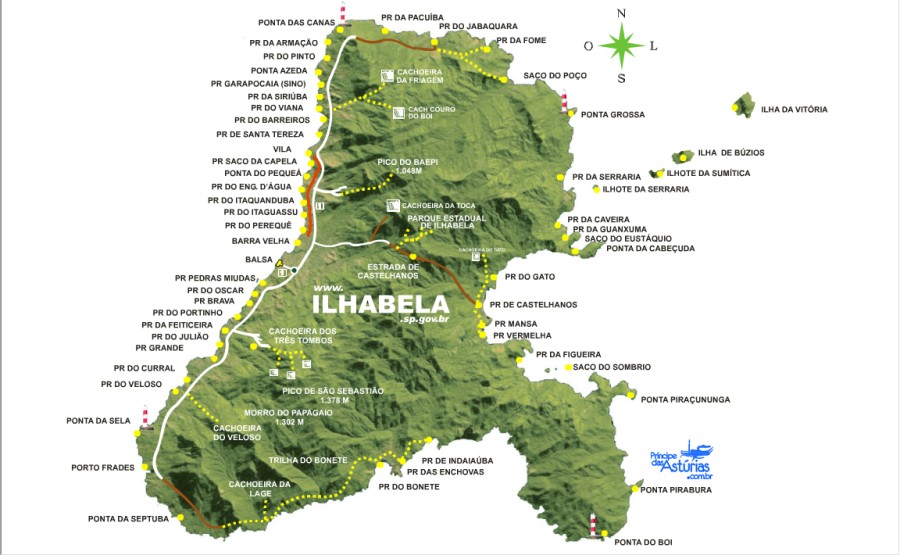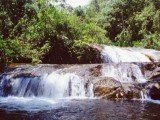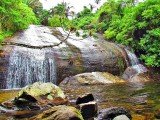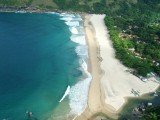Este post também está disponível em:
Português
English
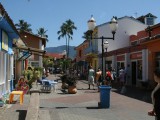
Ilhabela is the most popular place on the north coast of São Paulo.
The Municipality of Ilhabela comprises: São Sebastião Island, Búzios Islands, Vitória Island (inhabited), and more the islets: das Cabras, Serraria (in front of the beach of the same name), Castelhanos, lagoon, Figueira (in Castelhanos bay) and das Enchovas (in Enchovas bay).
Ilhabela is a large mountainous island covered with Atlantic Forest, with more than 40 beaches, some practically deserted, and many waterfalls.
Almost the entire area is protected by a state park. On weekends and during the summer seasons, it receives many tourists attracted by the harmony between the preserved natural beauty and the charm of a small town that offers nice inns and good restaurants.
Its geographical characteristics favor the practice of different sea sports, such as sailing, surfing and windsurfing, and hiking through forest trails. Shipwrecks and islets provide good diving spots.
Getting to know the most isolated beaches on boat trips is another great program.


Ilhabela - Drone

Ilhabela - Reportagem

Ilhabela praias e trilhas

Farol Ponta do Boi em Ilhabela

Ilhabela Guia de Turismo
In July, the city receives Brazilian and foreign sailors for the main nautical competition of the country, the International Sailing Week, in which boats of various classes participate.
Magnificent vacation homes in Ilhabela
Beaches in Ilhabela
On the side of the island facing the mainland, the sea has calm waters and is sought after by those who practice sailing, windsurfing and kayaking. It is where the small urban area is concentrated, squeezed between beaches and mountains.
Pristine-looking beaches with strong waves or secluded corners in small coves with clear waters are on the side pointing towards the open sea.
See photos and videos of Ilhabela beaches
To reach these places you have to face dirt roads, walk long trails or rent a boat.
Baía dos Castelhanos, Saco do Sombrio, Fome and Bonete are some of the most beautiful beaches in Ilhabela.
See the detailed map of Ilhabela
Waterfalls in Ilhabela
Cachoeira da Escada (located on the Castelhanos Road)
The course of the water goes through the stones and vegetation of the forest, thus making a ballet of the waters, with a relaxing movement. It has near the wells, area for rest. The trail is signposted.
You can go by car to the Ilhabela State Park, where there is parking, bathtub, and place to drink water. Do not forget the repellent, camera and tennis.
Cachoeira da Lage (typical Atlantic Forest vegetation, it is possible to find several animals)
The course of the river forming several falls, toboggans and beautiful natural pools. This is Lage waterfall. A 40-minute walk along the Bonete trail is the way to adventure.
It is worth going down the waterfall to the sea, where at low tide, the wreckage of a shipwreck can be seen. Level of difficulty of the trail: low to medium. It is advisable to wear sneakers and have a guide. It is advisable to bring a snack due to the distance of the trail.
 Cachoeira da Toca (located inside Fazenda da Toca)
Cachoeira da Toca (located inside Fazenda da Toca)
Natural showers, historical trails, ecotourism and camping. Pirate ruins, natural toboggans, rock surfing. Toca is all this and more. One of the most traditional tourist spots in Ilhabela.
Its toboggans formed by the courses of the waters, takes you to a fall in the natural pools, ensuring a lot of adrenaline and excitement. You can also try the traditional brandy in the still of the den.
Cachoeira do Gato (recognized worldwide for its exuberance and its enormous volume of water throughout the year)
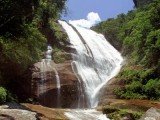
Absolutely unmissable for its exuberant nature, the Gato waterfall is the most visited in Ilhabela.
The paradisiacal setting is ideal for those who like a bit of adventure: the waterfall can only be reached through a trail located on the left side of Castelhanos Beach. The presence of a guide is advisable.
Cachoeira do Veloso (access through private property)
Departing from Veloso beach, by a 40-minute trail, you arrive at a place of rare beauty a fall of approximately 70 meters, with its wells of transparent and refreshing water.
The gift is on the trail back, where, from some points, you can see an unforgettable landscape of the canal. It is advisable to use repellent, a good pair of sneakers, and a camera.
Nature will pose for you. And you are sure to take some of the most beautiful pictures of your life.
 Cachoeira dos Três Tombos (in each part of the trail there are wonderful points with waterfalls)
Cachoeira dos Três Tombos (in each part of the trail there are wonderful points with waterfalls)
Located near Praia da Feiticeira, three waterfalls are part of this beautiful scenery of nature. The largest of them plummets from a rocky wall 20 meters high.
In its natural and crystalline pools, you can take a dip and delight in the natural showers formed by the waters. Its trail is of low difficulty.
Adventure Sports in Ilhabela
The climatic conditions, the relief and environmental preservation, make Ilhabela the Capital of Adventure Sports
Kitesurfing on the most beautiful beaches, rappelling in beautiful waterfalls, with descents ranging from 50 to 80m of emotion and adrenaline; several trails to unveil many waterfalls, rich flora of lush Atlantic forest. Horseback riding, through trails in the Atlantic Forest, passing by waterfalls and beautiful landscapes, with selected animals trained and well treated. All infrastructure and security with experienced guides.
Sport Fishing in Ilhabela
Sport fish that can be hooked around Ilhabela
It is perhaps the most common fish caught in Ilhabela with artificial lures. They can reach more than 15 kg, although the average is between 1 and 7 kg. They usually hunt for small fish near the coasts where the sea hits hard, but they are also found on parcels, in open water and also along beaches and sometimes even in bays.
The largest specimens usually live in deeper areas, usually over a parcel. They are very aggressive and provide a spectacular fight. The most common way to catch them is by casting artificial lures, but fly fishing also works, as well as other techniques. They are abundant throughout the year.
Bike in Ilhabela
Radical is to face a trail in the middle of the forest!
Getting to know Ilhabela by bike is a great choice, a bike path is practically ready that connects the ferry to the village, a flat circuit with more than 10 km passing through beautiful coconut trees on the shore. Another more radical possibility is to face a trail in the middle of the forest or a down hill for the more radical.
Kayaking in Ilhabela
Calm waters make the São Sebastião channel an ideal place for this practice
The São Sebastião channel, besides being one of the most beautiful coasts in Brazil, provides a peaceful kayak ride through its protected waters. Exercise your body and relax your mind in a delicious paddle. And get to know Ilhabela’s waterfront from another point of view.
Diving in Ilhabela
The Brazilian Bermuda Triangle
Dozens of shipwrecks dot the coastlines of the Ilhabela archipelago.
The explanation for so many shipwrecks would be that the vessels had their navigation instruments altered by an inexplicable and mysterious magnetic field, which caused the vessels to deviate many miles from their routes and collide in full with the submerged rocks and slabs of the coast.
Dozens of vessels, including tugboats, freighters, old sailing ships, steamers and passenger ships, as well as being home to the inhabitants of the seabed, are a delight to modern divers.
Among the vessels that have sunk around the island of São Sebastião, we can highlight the Brazilian freighters “Aymoré” (1920), “Therezina” (1919) and “Atilio” (1905), the British “Whator” (1909), and the Spanish “Principe das Asturias” (1916), a luxury liner that sank on a Carnival Tuesday, registering an official death toll of 477.
There is speculation, however, that hundreds of refugees from World War I who were in the holds of the liner also died.
Motocross in Ilhabela
Discover the charms of Ilhabela
Freedom to make your own itinerary, from north to south of Ilhabela, discover many beaches, trails and waterfalls in a fast, practical and economical way.
Off Road in Ilhabela
The Castelhanos beach road, in the Ilhabela archipelago, attracts many off-roaders.
In high season, around 300 vehicles a day travel the trail that gives access to the beautiful and mysterious beach. Powered by 4×4 vehicles, the adventurers who live with their feet (and heads) in the mud, seek the road due to the local weather conditions, with periodic rains and high humidity levels.
Castelhanos is 22 kilometers long, leaving sea level and reaching more than 800 meters of altitude, with great challenges for jeepers. Until reaching the beach, the route lasts 1 hour and a half, with several stretches that deserve attention.
To facilitate rescue, in case of accidents or vehicle breakdown, the jeepers gave names to the most dangerous points – Imbiruçú, Canas, Morro do Sabão, Volta Grande and Mãe D’água.
These places are very slippery, steep and have huge rocks. Even so, there are frequent falls of trees and collapses of ravines, which gives more emotion to the walk.
For these and other reasons, it is essential to have an appropriate car before venturing on the trail. The Castelhanos trail crosses several rivers and waterfalls and, at various times, those who are not used to the sport, think that the vehicle will not be able to pass due to the mud on the road.
Horseback riding
Horseback riding through the most beautiful islet in Brazil
A perfect invitation to enjoy nature as a whole is a horseback ride, trotting along trails and dirt roads. With daily departures the guided tour to the White water waterfall takes round trip 2 hours.
Trails in Ilhabela
Trilha of Água Branca
Level of Difficulty – Low
With 2,145 meters long, it is the most signposted trail on the island, with resting points for outdoor picnics and identification of the various species of trees. Delicious waterfalls and natural pools refresh the walk. It starts at the State Park guardhouse, on the Castelhanos road.
Trail of Cachoeira do Boi and Friagem
Level of Difficulty – High
Located north from Viana beach in Ilhabela a trail forks leading to the Couro do Boi and Friagem waterfalls.
These are a 3 hour walk away but require an experienced guide to reach.

Veloso Waterfall Trail
Level of Difficulty – Medium
Located in the south of Ilhabela, the walk takes the visitor to interact with the Atlantic forest, and its main attraction is the waterfall with approximately fifty meters high, with a well of about seventy square meters and an average depth of one meter seventy.
Duration time: approximately forty minutes.
Trail of Mansa and Vermelha Beach
Level of Difficulty – Low
From Castelhanos in Ilhabela you can reach these three beaches through a trail that leaves from the south side of the Bay. It takes 30 minutes to the first beach, where it is worth a short stop.
Through the forest, following for another 45 minutes you reach the Red beach. About two more hours away is Figueira beach. All with peculiar charms, they are natural habitats of the fauna and flora of the Atlantic forest and people who live from fishing and handicrafts.
Trilha da Serraria, Guanxumas, and Eustáquio
Level of Difficulty – Medium
Serrariana Ilhabela is composed of a simple and small traditional community. From there you will walk 1 hour to the beach of the skull, a beach not inhabited, but beautiful.
From there, you walk 40 minutes to Guanxumas beach, also populated with a traditional community, and finally, another 20 minutes to Saco do Eustáquio beach, a well-structured beach with bars and restaurants, busy and great for diving.
Trilha do Bananal
Level of Difficulty – Medium
Located in the central part of the island, this trail draws a lot of attention because the trail passes through an old bananal where the presence of animals and also huge native trees is common. As a reward it is possible to bathe in the waterfall.
Duration: approximately one and a half hours.
 Bonete Trail and Lage Waterfall
Bonete Trail and Lage Waterfall
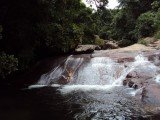
Level of Difficulty – Medium
The endeavor requires good physical shape and if possible an overnight stay at Bonete Beach (there are accommodations).
From Ponta da Sepituba, where there is a parking lot, the 13 km of trail are quite bumpy and cross three waterfalls that are great rest stops. The journey takes three to four hours of walking.
São Sebastião Peak Trail
Level of Difficulty – High
This takes the visitor to the highest point of Ilhabela which is the Pico de São Sebastião, reaching 1,379 meters. It requires a good physical conditioning to do this walk, and as a reward it is possible to fully interact with the exuberance of the Atlantic forest in its dominant stage.
Duration: approximately eight hours.
Baepi Peak Trail
Level of Difficulty – Medium
Climbing the Baepi Peak in Ilhabela (1,025 meters high) is a challenging 4-hour steep walk through the forest. An authorization from the Park administration is required, as well as the accompaniment of guides.
Climbing should be avoided on rainy days. On a clear, cloudless day the view from the peak reaches the Ilhabela mountain range, the channel and a good part of the Serra do Mar.
Trilha do Poço
Level of Difficulty: High
It is at the end of the road north of the island. After Jabaquara beach, following for 4 hours on a trail near the coast you reach Poço beach, where a waterfall falls on the sands, forming a freshwater pool.
Trilha dos Três Tombos
Level of Difficulty – Low
Located in the south of Ilhabela, Feiticeira, the trail provides three attractions: natural pool, toboggan and a fall of approximately thirty meters, great for relaxation. Used for rappelling.
Duration: forty minutes.
Trails for all tastes…
Discover many beaches and waterfalls only accessible by trails through closed forest and rich in species of exotic fauna and flora such as heliconia, bromeliads, toucans … Experienced guides take you through the trails of Ilhabela with safety and fun, crossing the Ilhabela State Park.
Ilhabela tour and travel guide
